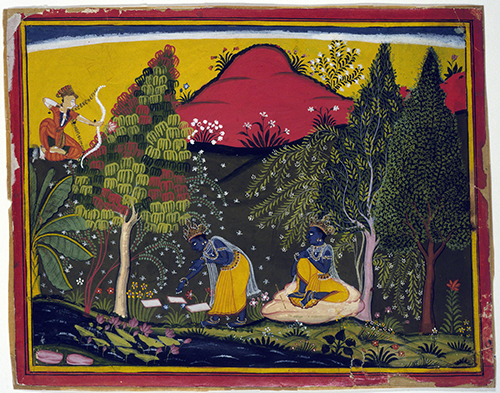Earth Appreciation Month: Rajput Painting
There is nothing I like more than the colors of nature awakening to spring. I especially love the arrays of greens that are seen in the grass, foliage, and trees. To celebrate Earth Appreciation Month, again, I’m presenting to you one of my favorite book illustrations from India. The colors in this illustration are so luscious, and really do put me in mind of the nascent season.
 |
| India, Krsna Interrupted by Kama (Desire), page from the poetry epic Gita Govinda (“Song of Krsna”) by Jayadeva, from Rajasthan, 1650–1660. Opaque watercolor and gold leaf on paper, 7" x 8 7/8" (17.1 x 22.5 cm). © 2019 Brooklyn Museum. (BMA-1176) |
This illustration really does not display much, if any, of the influence of Mughal painting with its interest on realism. Rajasthan was part of the Mughal Empire, the art of which was greatly influenced by Iranian and, ultimately, Western European Renaissance manuscripts. The landscape displays the traditional layering of horizontal bands of different colors to depict depth, with fanciful trees that are out of proportion to the figures. The page also displays more than one event in the life of Krsna in the same page.
In traditional Rajput painting, the colors would vary slightly in each section to indicate elapse of time, whereas this page does not. The foliage is depicted in the manner of mid-1600s Mewar school painting, with a hierarchy of leaf shapes and flat floral forms sprinkled throughout the page. In this scene, Krsna’s attempt at solitary meditation is interrupted by lust (i.e. Kama, the god of desire). Krsna is depicted calmly at ease on the right in meditation, and in amorous agitation as he retrieves love note left by worshippers. His agitation is reflected in the dramatically different tree form above him on the left.
The illustration of books was the primary vehicle for painting in India starting in the 1000s CE. Numerous local schools of painting developed. By the advent of the Mughal domination of India (1526–1700s), books of both Muslim and Hindu subjects were lavishly illustrated. Despite the influence of the Mughal court style, however, many regional schools in Rajasthan maintained a distinctively indigenous naivete. This was a contrast to the Mughal interest in an idealized naturalism in painting. In the Punjab, a region dominated by local princes, the various courts developed styles that were a synthesis of the Mughal and Rajput (indigenous painting of Rajasthan) painting styles, a blending of the real and the conceptual.
Correlation to Davis programs: A Community Connection: 2.5; Experience Painting: 2;The Visual Experience 3E: 14.2


Comments